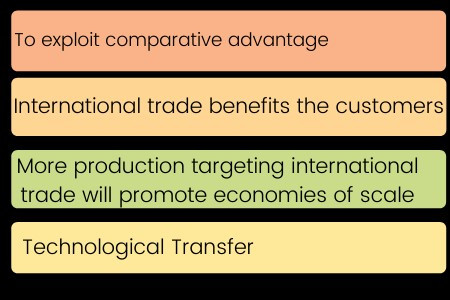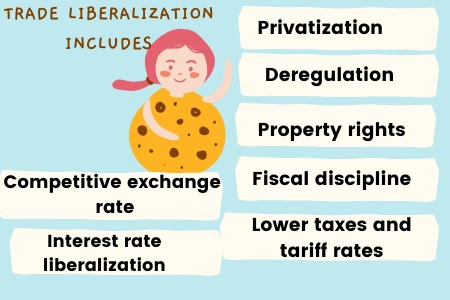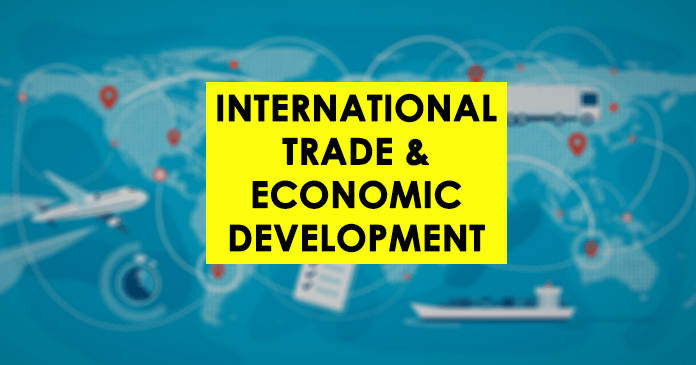Why developing countries should focus on international trade as a mean of achieving higher economic development?
Let’s see.
We discuss the top 4 reasons why developing countries should focus on international trade.

1. To exploit comparative advantage
- Most developing countries specialized in an industry that is comparatively advantaged to them.
- Manufacturing these products and exporting to other international markets will gain income for the developing country.
- Emerging economies such as China, India, Brazil, Vietnam, and other Asian economies need more natural resources to keep their production levels.
- Most developing countries have natural resources.
- Extracting these natural resources and exporting them to foreign markets is advantageous to developing countries.
- The price for these natural resources (such as oil, coal and other minerals, etc) continuously rising.
- Foreign income gained will improve the economic growth of developing countries.
- It helps with the development of the nation (developing countries).
2. International trade benefits the customers
- New products improve customer satisfaction.
- Products have competitive prices
- Price competition will reduce prices in the local markets (developing countries).
- Economic growth will improve.
- The living condition will improve leading to economic development.
3. More production targeting international trade will promote economies of scale
- Organizations are increasing their products and services as new market opportunities arise.
- New markets require organizations to expand their capacities.
- Higher capacities allow organizations to gain economies of scale.
- Organizations are able to improve their sales and profitability.
- The government can earn high corporate and personal income taxes.
- The government can spend these tax income on development projects.
- Less dependence on foreign sources of funding for development projects.
4. Technological Transfer
- When organizations from the developing countries enter into international trade they can experience the technological advancements in the developed countries.
- Organizations can easily adapt these new technologies or develop networks that facilitate them to share expertise in each field.
- Organizations can gain membership of international industrial organizations that enable them to share knowledge.
- Technological advancement enables firms in developing countries to improve efficiency and profitability.
- These organizations can transform their expertise to local businesses through employees.
Under the heading of International Trade and Economic Development, we first discussed the reasons why developing countries focus on international trade. Now let’s see barriers for trade for a developing country.
Barriers to Trade for a Developing Country
1. Most developing countries are specialized in exporting primary products, natural resources, or basic exports.
Reasons:
- Falling prices of natural resources such as gold, coal, oil, and other minerals.
- Depletion of natural resources.
- Demand for natural resources are reducing (iron).
2. Price Fluctuation for natural resources
Inelastic demand and supply for natural resources and agricultural products.
3. Developing countries have less access to international markets
- Developing countries produce basic products.
- Their technological and quality concerns are low.
- Developed countries put non-tariff barriers.
- Developed countries protect their own industries/ manufacturers and discourage exporters of developing countries by following a protectionist policy.
- Weak currencies of developing countries are uncompetitive in international trade.
- Developing countries lose income through currency conversion.
Policies that can promote international trade to develop the economies of developing countries
Here we discuss some policies that can promote international trade to develop the economies of developing countries.
1.Import Substitution Industrialization
Governments of the developing countries charge taxes/tariffs on imported commodities with the expectation of protecting local manufacturers whereby moving the economy from manufacturing primary products (such as agriculture) to manufacturing products (value-added products).
The government needs to identify the domestic industries, offer subsidies, and follow the protectionist approach.
Benefits:
- Protect the national economy and national industries.
- Developing economies are less dependent on foreign companies.
- Create domestic job opportunities.
- Protect local culture and local society.
Weaknesses:
- This policy might create jobs in the short run but lose jobs in the long run.
- Once you protect your domestic industry other countries will ban your exports.
- Customer satisfaction and cost is high.
- Competition is less and price high.
- Higher inflations in the local economy.
2. Export Promotion
Export promotion policies reflect the interest of national governments to stimulate exports. What are the main instruments used to export promotion?
- Subsidies
- Tax exceptions
- Special credit lines

This helps to encourage exports, increase GDP, and create new jobs and income, economic development.
Benefits:
- Developing nations can move from trading primary products to advanced products.
- In the long term developing nations can invest in advanced manufacturing industries and gain benefits.
Weaknesses:
- Other countries (your trading partners) may follow a protectionist approach.
- High chance to further worsen the income inequality in the economy (developing country’s).
- The larger business class becomes richer where poorer people do not receive the benefits.
3. Trade Liberalization
Removal of tariff barriers, quotas, export subsidies, and administrative legislation.
Government policies to support trade liberalization includes,

- Privatization
- Deregulation
- Property rights
- Competitive exchange rate
- Lower taxes and tariff rates
- Fiscal discipline
- Interest rate liberalization
4. Bilateral and Regional Preferential Trade agreements
- Bilateral or multilateral Trade agreements
- Assumption: Creating more agreements will make more international trade for developing countries.
- Trade agreement between countries in a trade block (EU, NAFTA, Central American FTA).
- Trade agreements to reduce tariffs.
5. Diversification (in exports)
- Most developing countries are specialized in primary product export (demand and supply are inelastic).
- Maintain and create competitiveness in the international market.
- To solve this developing countries should move to the manufacturing and semi-manufacturing sector and export these products.
Ex: Rather than exporting cotton the developing country can manufacture yarn, fabric, or garment manufacturing and then export
- Developed nations often create barriers to these developing nations (non-tariff barriers, embargos).
- The government of developing nations should concentrate on developing a skilled workforce to promote diversification in their country.
All right then. I really hope you enjoyed this article.
If you enjoyed this post, I’d be very grateful if you’d help it spread with your friends and colleagues!


